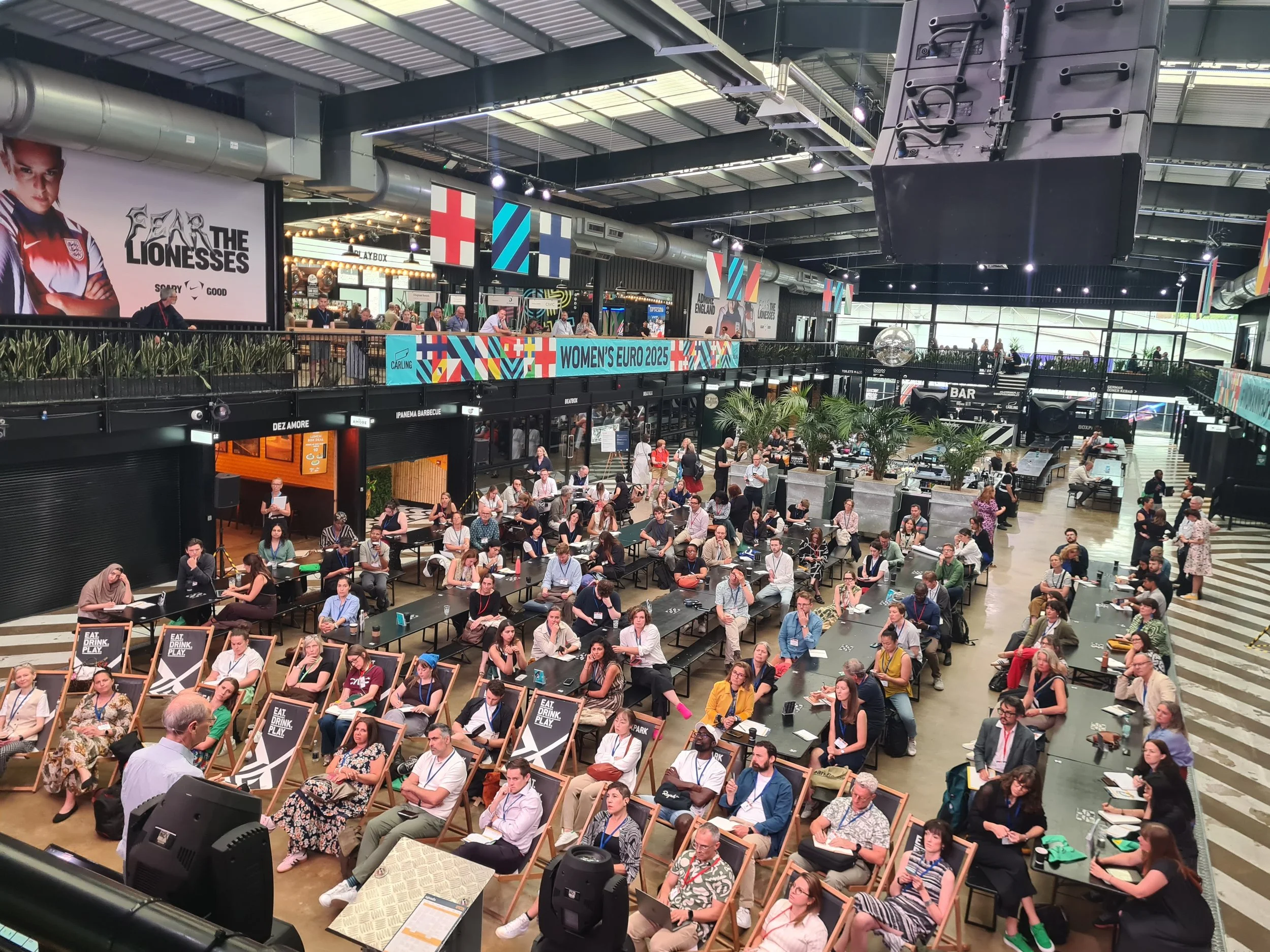Designing for Dignity: Intergenerational Living at Festival of Place 2025
On 2nd July 2025, Concept Culture joined the vibrant community of designers, developers, policymakers and placemakers at Festival of Place, hosted at Boxpark Wembley. Curated by The Developer, the event brought together those at the forefront of shaping more equitable, connected and sustainable built environments.
Our Founder and Creative Director, Tanisha Raffiuddin, chaired a timely and thought-provoking session:
Housing for Older People: Healthy Homes and Intergenerational Living
The panel explored what it really means to design homes and neighbourhoods where older people can thrive, not just live, and how we create systems, policies and places that support generational connection and long-term wellbeing.
Tanisha was joined by three inspiring speakers:
• Charlotte Miller, Co-Founder, Intergenerational England
• Jude Leighton, Head of Housing, United St. Saviour’s Charity
• Simon Beck, Senior Development Manager, Related Argent
Tanisha, Jude, Charlotte, Simon (L-R)
Intergenerational Living: From Aspiration to Reality
Charlotte Miller opened the session by reminding us that “housing is not just shelter, it's social infrastructure.” At Intergenerational England, her work has shown that while people want to live in more age-diverse communities, our systems, from planning to policy, haven’t caught up.
She described intergenerational housing as a spectrum, from shared gardens and communal spaces to purpose-built developments. What ties them together? Intentional design that creates conditions for connection, not just proximity.
Her team’s research revealed that:
📊 Only 3% of UK homes are age-adapted
📊 Just 2.1% of households are multigenerational
📊 86% of adults believe age-mixed communities build respect
📊 Intergenerational models reduce loneliness by up to 45%
Despite this, “we keep designing cities in silos,” Charlotte noted. At Intergenerational England, they’re pushing to shift this narrative, through advocacy, metrics, and cross-sector partnerships. One standout tool: an intergenerational social value framework co-developed with architects and housing associations to quantify the impact of age-diverse living.
Measuring Wellbeing and Designing With, Not For
Jude Leighton brought deep experience from her work at United St. Saviour’s, where she has helped reimagine the traditional almshouse as vibrant, community-centred homes for older residents.
One of the standout lessons? Co-design works. At Appleby Blue, residents were actively involved in the design process, resulting in thoughtful touches like a communal bath, private washing machines, and courtyard-facing windows to nurture community.
Jude’s team also uses the Outcome Star tool to track resident wellbeing across five key areas: mental, physical, financial, social, and family connectivity. They meet with each resident every three months to assess and support their progress.
“It’s the social connectivity we need to prioritise. That’s what moves the needle on loneliness and wellbeing, not more digital services..”
Sir Michael Marmot and Christine Murray
Private Sector Lessons: Design from the Centre, Not the Edges
Simon Beck offered a large-scale developer’s perspective from Brent Cross Town, where Related Argent is delivering a 180-acre regeneration in partnership with Barnet Council.
His team recently gained planning approval for a 148-home later-living scheme located right at the heart of the masterplan, not on the outskirts. This intentional placement supports interaction, vibrancy and visibility.
Simon emphasised that meaningful intergenerational living means looking beyond the bricks and mortar.
“It’s often the softer, less tangible things, like the public realm, events programme and human-scale retail, that spark connection.”
One of the innovative measurement tools discussed was the Flourishing Index, developed in collaboration with the University of Manchester to measure community wellbeing using both quantitative and qualitative data. The goal? To track how people feel and connect in place over time, and use those insights to design better.
Dr. Nourham Bassam (Founding Director, The Gendered City), Tara Gbolade (Co-Founder and Director of Gbolade Design Studio) and Dr. Eve Avdoulos (Senior Associate, We Made That)
Final Takeaways
To close the session, Tanisha asked each panellist: If you could change one thing about the housing system to support older people better, what would it be?
Their answers:
“Reframe housing not just as infrastructure, but as a tool for health, equity, and belonging.”
“Build homes that are good enough to make people want to move, freeing up under-occupied housing and improving lives.”
“Educate developers and local authorities about the full spectrum of age-specialist housing, and shift the narrative around ageing from decline to opportunity.”
As Tanisha closed the session:
“Aging is a privilege. Designing for older people isn’t niche, it’s necessary. And when we get it right for them, we often get it right for everyone.”
More Highlights from Festival of Place
Beyond the panel, we spent the day absorbing powerful ideas across keynotes, walking tours, and project showcases. A few standout moments were:
Sir Michael Marmot'spowerful keynote on healthy places ended with a poignant call to action: “Make hope possible, not despair convincing.” Marmot Places is essential reading for anyone who values healthy places.
At the Feminist Placemaking panel, Dr. Nourham Bassam (Founding Director, The Gendered City), Tara Gbolade (Co-Founder and Director of Gbolade Design Studio) and Dr. Eve Avdoulos (Senior Associate, We Made That) asked what cities would look like if they were designed to make women feel safe after dark. The answer? Radical, thoughtful, and overdue. Tara closed the panel with a compelling call to action: “If we were all paid based on how safe we make women feel in our spaces, what would we do differently?”
The panel on Net Zero and Decarbonisation shared pragmatic routes to retrofitting heritage buildings and incentivising green upgrades through tax reform.
The Paper Garden project in Canada Water, led by Dr. Jan Kattein, showed what happens when circular economies, community building, and carbon literacy come together, with 60% reclaimed materials and over 3,000 volunteers aged 6 to 76.
Finally, the story of Urban Mining at TBC London demonstrated how reused steel from a Regent Street retrofit found new life in a Southwark office. Proof that sustainability isn’t just idealism, it can outperform on cost and commercial success too.
Final Reflections
From housing for older people to feminist cities, regenerative practice to climate action, this year’s Festival of Place reminded us that good placemaking is fundamentally about people, and the stories, systems, and structures that shape our lives.
We left with bold ideas and even bolder questions.
What does it mean to build a city where everyone belongs?
How do we ensure dignity at every stage of life, from childhood to older age?
And what kind of places do we want to grow old in?
At Concept Culture, these are the questions that drive us. If you’re exploring the intersection of design, storytelling, and inclusive place strategies, we’d love to hear from you.
Are you looking for advice on how to create an engaging story for your place?
If you need help defining your target audience, developing your place narrative, expressing your place story, or ensuring your story reaches your audience, please get in touch. We’d love to offer you tailored branding and marketing support to grow and elevate your place brand through the power of storytelling.
Book a discovery call with us to discuss your branding needs.





